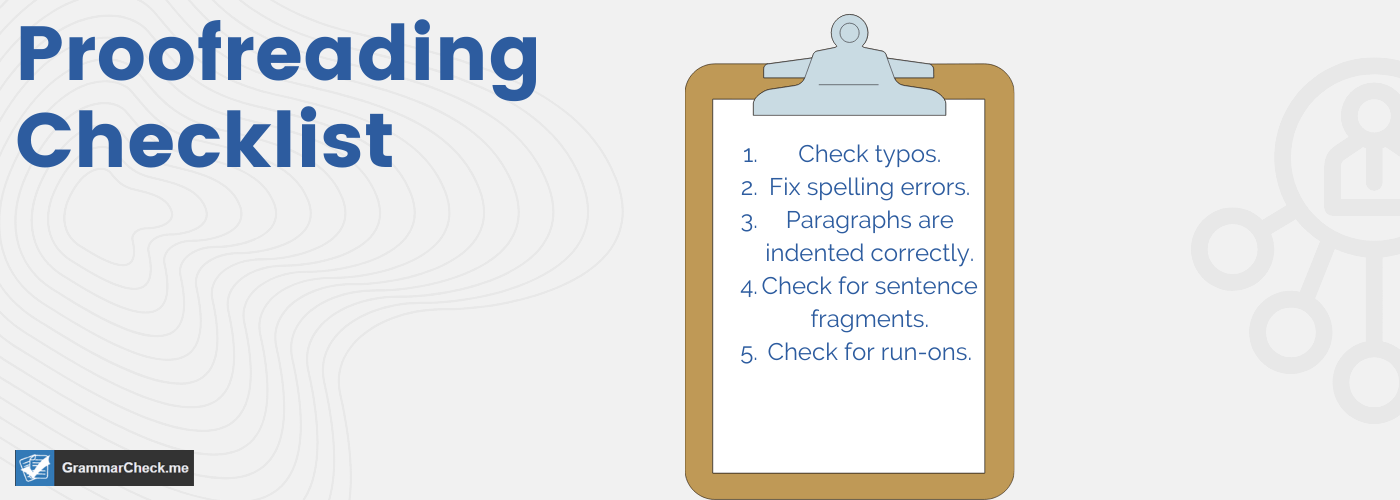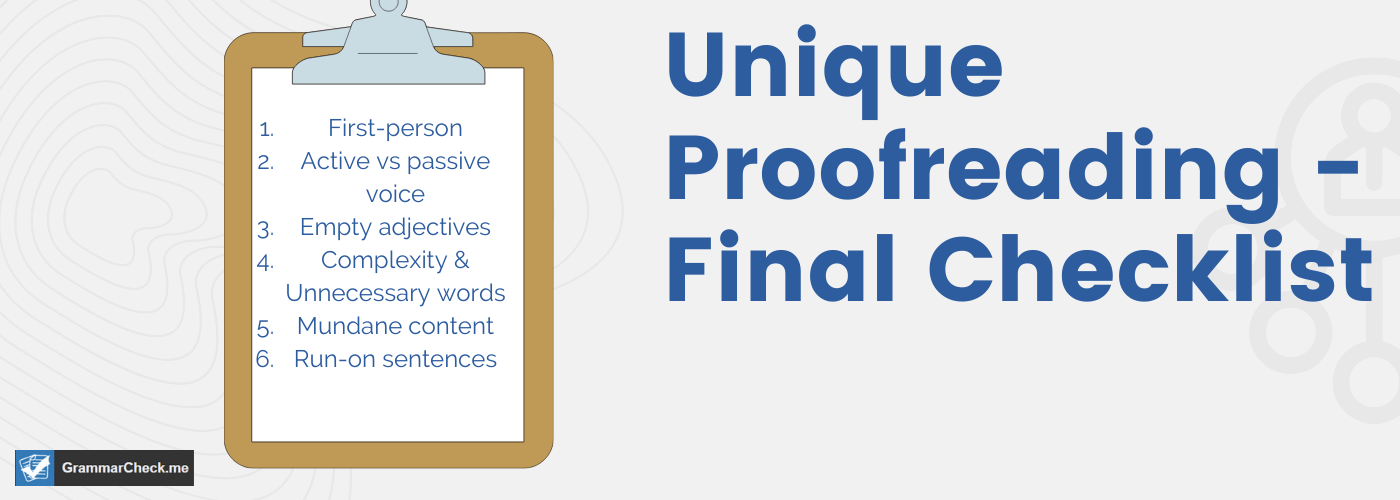Proofreading and editing your work is an important step in producing quality content. However, it can be easy to miss mistakes when you’re working on a tight deadline. Use this proofreading checklist to make sure your work is polished and ready for publication. By taking the time to edit and proofread your writing, you’ll ensure that your readers have a positive experience when they encounter your content.


Getting Started
Many of us already know why is proof reading important. But now you need a consolidated checklist to get started!
When you begin editing and proofreading your text, start with larger problems, such as clarity and structure. Make your focus increasingly narrower as you work. Focus on your overall points or arguments, then paragraphs, then sentences. After you have edited for content, structure, and quality, move on to proofreading for grammar.
Here is a proofreading & editing checklist that is sure to take your writing to the next level!
Editing Checklist
- Content is accurate, suits the purpose of the project, and follows all guidelines
- A great title is informative and engaging
- Page is formatted according to industry or project standards
- I have a thesis statement or main point to my writing
- I have an introduction
- I have a conclusion
- I have transitions between my paragraphs
- I have covered all necessary points for my topic
- All necessary information needed for my audience to understand my text is provided
- All paragraphs have one subject
- All paragraphs are clear
- I have eliminated unnecessary words
- The tone of my writing matches the audience and subject
- All sentences have one idea
- Sentence length varies
- Sentence meanings are clear
- Sentences are active, not passive
- All sources listed in a works cited or bibliography have been used in the text, and all others have been deleted
- I read the text aloud to find awkward phrases
- I edited the whole document
Proofreading Checklist
When you proofread, read through your text looking for easy-to-find errors, such as typos, and correct them. Then, focus on more specific errors. Take extra time to look for errors that you make frequently, such as comma mistakes. The Chegg paper checker can catch many of these errors!
Here are the main things to look out for when proofreading.
- Check typos
- Fix spelling errors (Use our Free Spell Checker)
- Paragraphs are indented correctly
- Industry-standard stylistic guidelines have been followed (citations, line spacing, page numbering, title pages, etc.)
- Verify your paragraphs have catchy & eye-grabbing sentence starters.
- Verify that any names or strange spellings are accurate
- Check for sentence fragments
- Check for run-ons
- Subjects and verbs agree
- Word choice is accurate, especially on tricky pairs that a text editor may not catch (your and you’re)
- Check quotations for proper formatting
- Ensure sentences are formatted correctly. Check all parts of a sentence are present.
- Check colons and semicolons
- No comma errors
- All final punctuation is correct
- I have not overused ellipses or exclamation points
- Reread any long or complex sentences for hidden grammar errors
- I have read the text front-to-back and back-to-front to check for proofreading errors
- I proofread the whole text
Now you know some of the most basic concepts to review during your proofreading. However, It is important to know why is proof reading important for a writer as well!
Structure & Format
Important to pay close attention to the structure and format of your work. This includes making sure that your sentences are well-constructed and that your paragraphs flow smoothly.
Remember, your format will depend on which kind of writing you are performing. Here are some examples.
- Blogging
- Business Memo
- Essay (Try our free online essay checker!)
- Research Paper
- Creative Story
Other things to watch out for:
Proofreading is a skill that takes practice, but it’s worth taking the time to do it right. It is often seen as a tedious task, but it’s an important one if you want your writing to be error-free. Here are a few things to watch out for when proofreading.

1) First-person
Any good writer knows that first-person point of view can be a great way to engage readers. After all, who doesn’t enjoy reading about someone’s personal experiences? However, first-person point of view can also be a trap, leading writers to rely too heavily on their own opinion and experiences.
When proofreading your work, watch out for signs that you may be veering into first-person territory.
For example, do you find yourself using words like “I,” “me,” and “my” more often than necessary? If so, it may be time to step back and reevaluate your point of view. Be sure that you are consistent throughout your writing.
If you want to make some extra money proofreading I suggest you check out the Proofreading Academy. After reviewing proofreading academy reddit reviews it seems like a great course!
2) Active vs passive voice
When proofreading your work, it’s important to be on the lookout for active vs passive voice. Active voice occurs when the subject of the sentence is performing the action, while passive voice happens when the subject is being acted upon.
In general, active voice is more direct and concise, making it easier for readers to understand. Passive voice can often make sentences sound clunky and complicated.
However, there are times when passive voice can be used effectively, so it’s important to know when to use each one. Use our FREE Sentence Checker to scan for active and passive voice in seconds.
3) Empty adjectives
When proofreading, it’s important to watch out for empty adjectives. These are words that don’t actually convey any meaning and are just used to pad out a sentence.
For example, “the hired help were very lazy and unprofessional” can be changed to “the hired help was lazy and unprofessional.”
Not only is this shorter and easier to read, but it also packs more of a punch. So next time you’re proofreading your work, make sure to watch out for those empty adjectives!
If you are pursuing any freelance writing jobs, it is critical to understand this basic principal. Keep this checklist handy during your writing to avoid making unnecessary mistakes.
4) Complexity & Unnecessary words
Making sure that your writing is clear and concise is one of the most important parts of copy editing or proofreading. This can be especially challenging when you’re dealing with complex topics or dense prose.
In these cases, it’s often helpful to take a step back and ask yourself if your writing is as clear and straightforward as it could be. If not, try to simplify your language and remove any unnecessary words. By doing so, you’ll make it much easier for your readers to follow your argument and understand your point.
5) Mundane content

When proofreading your work, it is important to watch out for mundane content. Boring content can quickly lose the interest of your reader, so it is important to keep your writing fresh and exciting.
One way to avoid boring content is to vary your sentence structure. You should also be sure to use vivid verbs & various descriptive adjectives. These words will paint a clear picture in the reader’s mind and keep them entertained!
For example, instead of writing a series of short, choppy sentences, try to vary the length of your sentences and use different types of sentence structures.
6) Run-on sentences & Sentence fragments
One of the most common mistakes that writers make is to create run-on sentences. A run-on sentence occurs when two or more independent clauses are joined together without the use of a conjunction or proper punctuation.
As a result, the sentence becomes difficult to read and can often be confusing for the reader. If you struggle with this, consider using our reword generator to streamline and simplify your writing! The best way to avoid run-on sentences is to ensure that each independent clause is properly punctuated with a comma, semicolon, or conjunction.
7) Punctuation
Punctuation mistakes can completely change the tone and message of any written piece. Teachers around the world constantly stress the importance of punctuation in writing. Incorrect punctuation can make an otherwise great argument or statement unintelligible, and distract from the meaning of a piece of writing.
Examples of punctuation include:
- Commas
- Periods
- Semicolons
- Apostrophes
This is why proofreading your writing for punctuation mistakes is critical. In fact, even the smallest punctuation errors can ruin a written piece!
FAQs – Proofreading
Here are some items to check while proofreading your own writing:
1. Make sure all the text is there and in the correct order. This might seem obvious, but it’s easy to miss a sentence or paragraph here and there, especially if the document is long.
2. Check for typos and other errors. Use our grammar checking tool for spotting typos. So read through your document carefully, looking for any errors.
3. Ensure that all names, dates, figures, etc., are accurate. Again, this might seem obvious, but it’s easy to make a mistake here and there. So check all the facts and figures to make sure they’re correct.
4. Make sure the grammar is correct. Fixing grammatical errors & writing in complete sentences can make a huge difference in the quality of your work.
When proofreading, here are the main things to look at during your proofreading process:
– Look for grammar mistakes & spelling mistakes
– Check for consistency within the document
– Check formatting
There are a few basics to proofreading any document, whether it be for work or for school. Use our editing checklist.
– Check for sentence fragments and run-on sentences. These can be easy to miss, but they can really change the meaning of what you’re trying to say.
– Make sure each sentence has a subject and a verb, and that they flow together smoothly.
– Use the correct verb forms.
– Finally, pronoun usage is important in ensuring that your writing is clear and concise.
There are three main stages to the revision and editing process: revising, editing and proofreading. Each stage has its own purpose and role in ensuring your writing is accurate, clear, and effective.
The easiest way to remember the difference is that “who” is always a subject, while “whom” is an object. For example:
Who do you think will win the game? (subject)
To whom are you speaking? (object)
There are a few things you can do to proofread your text messages before sending them. First, make sure to use proper punctuation. This will help to ensure that your meaning is clear and that there are no misunderstandings.
Second, take a break after writing the message before proofreading it. This will allow you to come back to it with fresh eyes and catch any errors you may have missed the first time around. Finally, read the message out loud before sending it. If these steps are too much, you can always rely on the spell checker from Android or Apple!
1) Ensure the essay’s overall structure is clear and easy to follow. This means having a clear introduction, body, and conclusion.
2) Make sure the writing is clear and concise. Be sure to revise any confusing or vague sentences.
3) Make sure all of the evidence in the essay is well explained and makes sense in relation to the argument you are making.
4) Be sure your writing & sentence structure is consistent. If your writing is in present tense, avoid using passive sentences.
5) Take a step back from the essay and read it again with fresh eyes. This will help you catch any mistakes you may have missed before.
The Bottom Line
Proofreading your work is an essential step in the writing process. By taking the time to check for errors, you can ensure that your piece is polished and ready for publication. The checklist we’ve provided will help you catch every mistake, so use it next time you sit down to write. Tools like Grammarly or ProWritingAid or even the grammar checker QuillBot can make proofreading a breeze. Just a few minutes of proofreading can significantly improve the quality of your writing!
